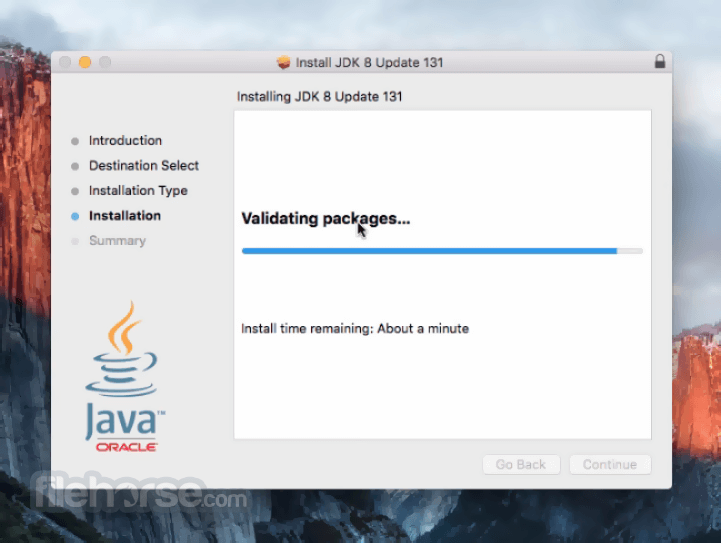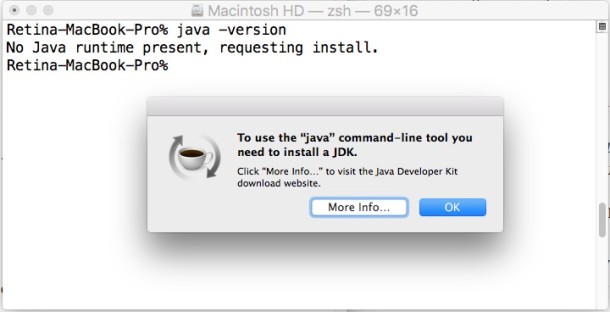
- Java for mac 10.11 how to#
- Java for mac 10.11 install#
- Java for mac 10.11 manual#
- Java for mac 10.11 code#
If you run into any problems, compare your terminal commands and output to:įor an example of how you might distribute your installer, take a look at:Ĭomments or Questions Send us a message Message: Name: Email:Īll the fields are optional. Be sure to check out the "About ShowTime" option 9) Try it outĪfter completing the installation, go into the "Applications" folder and open When you are ready to distribute to the public, you'll want to sign your application with a The reason is that the installer bundles the JRE (an Apple requirement for publishing Java

The executable JAR file ShowTime.jar checks in at a mere 0.001 MB,īut the installer file show-time-installer.pkg almost hits a whopping The javapackager tool is the way forward while the legacy JarBundler andĪppBundler approaches are now obsolete. srcfiles ShowTime.jar -appclass ShowTime \Ĭp out/ShowTime-*.pkg show-time-installer.pkg BappVersion=1.0.0 -Bicon=package/macosx/ShowTime.icns \ $jdk/bin/javapackager -deploy -native pkg -name ShowTime \ Tool to build the ShowTime.app appplication and wrap it in into an installer: Use the following commands to move the icon file into the package folder and Sips -z 128 128 ShowTime.png -out ShowTime.iconset/icon_128x128.pngįor this tutorial, just ignore the Missing image for variant warnings (or Sips -z 100 100 -p 150 150 ShowTime.png -out ShowTime-background.png Image to appropriate dimensions for an icon, and convert it into the. Use the following commands to download a sample PNG image, resize the The default icon for an executable JAR is a coffee cup. 7) Create installer background and application icon
Java for mac 10.11 manual#
Note: While the manual commands above for steps #5 and #6 work fine, you could automateįile. Click the red button (marble) to exit the The "It's Showtime!" window with the current time should display in the upper

Test your executable JAR with the following command: Jar cmfv MainClass.txt ShowTime.jar *.class Now use the following jar command to create the "ShowTime.jar" file: The resulting manifest file contains a single line: Create the file:Įcho "Main-Class: ShowTime" > MainClass.txt Which class contains the "main" function. Instead we will create a more convenient executable JAR file.īefore we make an executable JAR file, we need a manifest file to indicate It is possible to run the class file directly, but that results in a poor userĮxperience. Simple window for displaying the current time:į.setDefaultCloseOperation(JFrame.EXIT_ON_CLOSE) į.getContentPane().add(new JLabel(new Date().toString())) īack at the Unix prompt, compile the Java program into a class file:
Java for mac 10.11 code#
Get the sample Java code and take a look at the Swing commands that create a The first command creates a folder called "showtime", and the second command Open Terminal and you're now at the Unix prompt.Įnter the following command to verify Java is installed: Using Finder go into "Applications" and then open the "Utilities" folder. * javapackager not available in JDK 11 2) Launch Unix terminal
Java for mac 10.11 install#
Screenshots 1) Install Java SE Development Kitĭownload and run the Java SE 10 JDK* installer for macOS: (For the truly impatient, you can even run through the whole

This step-by-step tutorial that can be easily completed by a beginner level developer. Have successfully completed the tutorial with the sample Java program, modify the steps to The instructions below step you through the process from scratch withĪ sample program called "Show Time", which simply displays the current time. It's simple to turn your Java Swing program (.jar) into a proper macOS application with a This information is for an older version of macOS.įor more current information, visit: Mac Java!
Java for mac 10.11 how to#


 0 kommentar(er)
0 kommentar(er)
